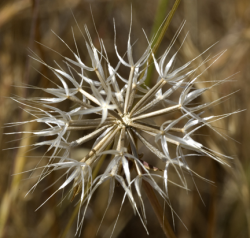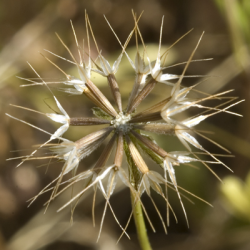
threatened

Photo taken in the Scott Creek watershed © 2007 Dylan Neubauer.

Photo of sympatric Microseris bigelovii in fruit in the Scott Creek watershed © 2007 Dylan Neubauer.



This fact sheet was prepared by Dylan M. Neubauer under award NA04N0S4200074 from the National Oceanic and Atmospheric Administration (NOAA), U.S. Department of Commerce (DOC). The statements, findings, conclusions, and recommendations are those of the authors and do not necessarily reflect the views of the NOAA or the DOC.
© Copyright 2006, Elkhorn Slough Coastal Training Program
Last updated: Nov 29, 2018 12:45
Common Names - Santa Cruz microseris
Family - Asteraceae (Sunflower Family)
State Status - none
Federal Status - none
Habitat
Sheltered grass and herb rich understory of coast live oak (Quercus agrifolia var. agrifolia) savannah; openings in coastal scrub or chaparral on shale or mudstone where grass competition is reduced; 10-500 m.
Key Characteristics
Allo-tetraploid species derived from two diploid species: coast microseris (Microseris bigelovii) and silver puffs (Uropappus lindleyi). ± scapose annual herb, 1–6 dm tall, sap milky; leaves gen all basal, entire to pinnately lobed, glabrous or mealy, hairs drying as minute, white scales; single, liguliflorous head on naked peduncle, ± nodding in bud, ligules yellow, > involucre; involucre 6–19 mm, glabrous; phyllaries in 2–4 series, ± lanceolate, reflexed when dry, outer < 1/3 inner; fruit spindle-shaped, dark brown to purplish, tip not widened at base of pappus, pappus scales <= fruit (Chambers 2013). Stebbinsoseris heterocarpa differs in having larger fruits (4.5–12 mm), sometimes narrowed and long-tapered above, and pappus scales that are ±= in length to the achenes. Identification of Stebbinsoseris without mature fruits is not possible!
Flowering Period
April to May
Reference Population
Scott Creek watershed (Santa Cruz County).
Global Distribution
Endemic to California in Monterey, Marin, Santa Cruz, San Francisco, San Luis Obispo, and San Mateo counties (CNPS 2010).
Conservation
Known from fewer than 20 occurrences (CNPS 2010). The parents of the hybrid listed above can be confused with this species as the three can co-occur (as in the Scott Creek watershed). As of 2015, approximately 20 isolated colonies exist within the Scott Creek watershed, each exhibiting different recombinations of parental traits. It is not known if the gene flow betwee the diploid species is uni- or bi-directional, if S. decipiens can arise equally from the two parents, or if all or only few pollinations result in successful fertilizations and subsequent production of S. decipiens (West 2015).
Reference
Ferris, R. S. 1960. Illustrated Flora of the Pacific States, Vol. 4. Stanford University Press, Palo Alto, CA.
California Natural Diversity Database (CNDDB). 2015. California Department of Fish and Wildlife RareFind 5. http://www.dfg.ca.gov/biogeodata/cnddb/mapsanddata.asp [accessed 6 March 2015]
Chambers, K. L. 2013. Stebbinsoseris decipiens, in Jepson Flora Project (eds.). Jepson eFlora, http://ucjeps.berkeley.edu/cgi-bin/get_IJM.pl?tid=76211 [6 March 2015].
CNPS, Rare Plant Program. 2010. Stebbinsoseris decipiens in Inventory of Rare and Endangered Plants (online edition, v8-02). California Native Plant Society, Sacramento, CA. http://www.rareplants.cnps.org/detail/1087.html [accessed 6 March 2015].
West, J. A. 2015. Traversing Swanton Road. http://arboretum.ucsc.edu/pdfs/TraversingSwanton.pdf [accessed 7 March 2015].
